The exhibition “Ausgekocht?” of the Museum “Women’s Culture Regional – International” in Fürth is currently exhibited as a temporary exhibition at the Women’s Museum in Meran until 30th November 2019.
Gudrun Cyprian and Gaby Franger
‘Ausgekocht?’ – Reflections on the Global Food System and the Role of Women through the Exhibition of the Museum `Women’s Culture Regional – International`
The exhibition “Ausgekocht”[1] presents central contradictions in cooking and eating worldwide. The social processes of cooking and eating cause negotiations and change. Obvious are adjustments of gender roles, be it in agriculture or the automation of kitchen work, and economic and cultural change. With installations, art, stories of women and the discussion of contentious issues, the exhibition aims at showing what these global processes mean for women and their families, and which strategies women are developing in their everyday lives to confront them. In this article, we refer to various examples from the exhibition, giving voice to women around the globe while dealing with the right to food.
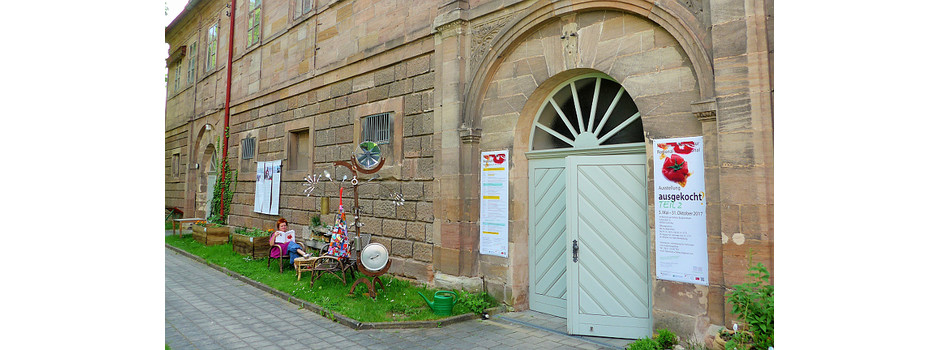
Women in One World
‘Women in One World. Center for Intercultural Research on Women’s Everyday Lives and International Exchange’, the association that runs the Museum Women’s Culture Regional – International, was founded in 1989 by researchers, artists and educators of different native languages as an interdisciplinary forum for cross-cultural studies and international solidarity. We describe and analyse processes that affect women in a specific way, we point out disparities, but at the same time, we open new perspectives for possible action. We narrate global developments as they are reflected in biographies of women who communicate and are crossing borders. This approach allows us to discover commonalities in apparent differences and to change the perspective on the self and the other, the familiar and the alien, on development and what is understood as so called under-development. With our museum, founded in 2006, we offer a space for dialogue, to discuss controversies both locally and globally, both related to the past and the present.
Our approach to conscientization (Freire) is mainly rooted in the structures of women’s own lives, their inherent wishes, and the capacities of women themselves. The Museum Women’s Culture Regional – International gives women a voice, a face and a lively forum.

“Ausgekocht”
“With every meal we make decisions with far-reaching consequences. Our food is inextricably linked to politics, business, society, culture, knowledge, agriculture, health and the environment. With no other human action we shape the world more than with food.”
Ursula Hudson, president of Slow Food Germany, protagonist in the exhibition[2]
The German word “ausgekocht” has a broad range of meanings. In the exhibition, we portray the different expressions and at the same time, we turn around and question all these meanings, which range from ’boiled’, ’decocted’, and ’concocted’ to ’there is nothing left to cook’, or refer metaphorically to someone being cunning or acting in a crafty way.
Cooking seems to be out of fashion – at least in the affluent societies and in middle classes all over the world: people cook less and less at home, it is possible to prepare quick meals because of industrial food processing and frozen foods. On the other hand, in many parts of Africa, Asia and Latin America there is nothing left to fill the cooking pot. There is a growing consciousness that eating habits and purchasing decisions in Germany or Europe have effects – often negative – on the situation of families on the other continents.
The right to food is a basic human right. Everyone is entitled to have access to sufficient quantities of healthy, nutritious food, enabling a life of human dignity. But cunning strategies of multinational agriculture and food industries, like land grabbing, patents on seeds, and taking advantage of national or European subsidies for export, lead to poverty and the loss of the livelihood of small-scale farmer families and environmental destruction. The large spatial and cultural distance between food production, processing, sale and consumption leads to an increasing alienation of the consumer from the food and its origins. Eating cultures and knowledge are lost along these long distances. When it comes to healthy nutrition, we have become increasingly dependent on the providers and companies on the food market. That raises questions about trustworthiness: How far can we rely on information given by producers whose main goal is profit?
Claudia Niedermann, Franconian entrepreneur woman 2015, and protagonist in the exhibition highlights processes of re-acquiring traditional knowledge about regional agriculture:
“As a young farmer woman, she had a small milk farm and some fruit and vegetable fields. It was nearly impossible for them to sell their fruit. Their customers, used to international food provisions in the supermarkets, asked for cherries already in April, three months before the harvest. They knew nothing about the harvest times of regional fruit and vegetables. Therefore, the choice for Claudia Niedermann was either to quit, because the income was not enough, or to think about changes. With her husband, she started fields where customers could harvest by themselves. But not only this: she developed educational programmes for kindergartens and schools, as well as for children and parents, to learn about agricultural processes, to learn what kinds of work there are to do from sowing to harvesting to the preparation of meals. Children very much like to produce apple juice from apples they harvested by themselves, or to taste delicious but crooked carrots that you could never buy in a supermarket.”
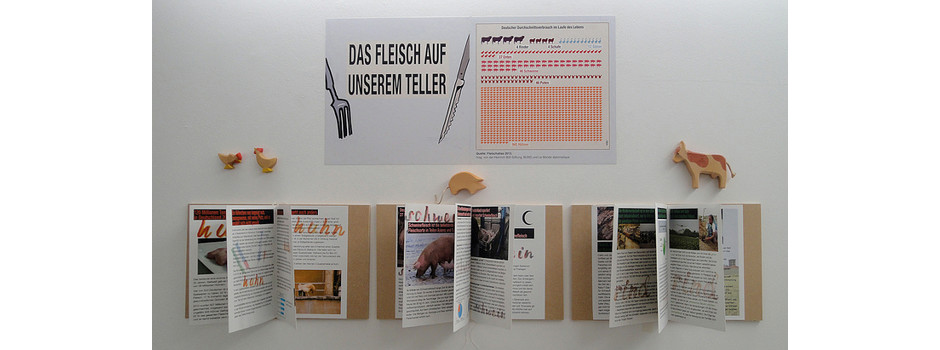
Global Agribusiness
The ongoing liberalization of the agricultural sector leads to the destruction of agricultural production structures and of the social fabric in the countryside. Around the world, women grow food, keep poultry and small cattle, and are responsible for up to 80% of the food production in developing countries, and around 50% worldwide (Welthungerhilfe 2014: 1). Highly subsidized EU agricultural products even receive export grants to compete on the world market. A great number of countries in the Global South cannot cope with the dumping prices for crops and meat resulting from the common agricultural policy in the EU.
One example demonstrating the absurdity of the global market and the EU subsidy policies is the destruction of the tomato industry in Ghana, which lead to the closure of local enterprises for tomato production. Farmers can no longer sell their crops, poverty is growing, and for many farmers the only solution is to flee to the places where the canned tomatoes come from – to Italy (Franger 2017).
We have to question and rethink these unequal power structures, but we also need new perspectives on the political and economic thinking about food security.
Devising the concept of food and meal security
Despite a volume of food production worldwide that could feed the current and even a growing world population, and in spite of the international commitment to reduce hunger in the world, the number of undernourished people in the world amounted to815 Million in 2016 (Herre 2017:4; FAO, IFAD, UNICEF, WFP and WHO 2017). However, the quantity of food available is not a sufficient indicator for food security. We have to focus on the possibilities and capacities to buy and provide sufficient food, both in terms of quantity and quality, regularly, and to all household members, regardless of gender and age. This means that food security has to focus on the “household” level (Amartya Sen 1981).
Obtaining good food not only means to receive the necessary calories, vitamins and minerals; human nutrition is deeply rooted in culture. Taking this into account as well as the long chain of (female) work and decisions necessary for adequate nutrition every day, we have to talk about meal security and meal policy. It is obvious that in most societies the preparation of the daily meals is a female task. Despite industrial food production and the change of life styles brought about by the food industries that provided instant and pre-cooked foods, and despite the rising employment of women outside the household, there is still a close connection between food and femininity. In the everyday lives of women all over the world, in the public imagination and in the emotional lives of women, they are the nurturing mother, the talented home cook (most acclaimed professional chefs are men), the conscious consumer and the under-control and health-aware eater. So far, gender aspects have been neglected in the discourse about food security. They have to be an integral part of all concepts, research and strategies at the micro, meso and macro levels.
Parto Teherani-Krönner, an agricultural and social scientist at the Humboldt University in Berlin, has developed this concept and applied it in her research: “The gender concept has to take into consideration: a) the resource allocation, b) the production process, c) the necessary technology and know-how, d) the institutional setting and decision making processes, and e) the historical background to the socio-cultural dimension of gender relations as well as the symbolic value of food and nutrition.[…] Food security and safety include more than just production, marketing, food supply, distribution, and consumption. If a safe household and family nutrition is the aim, the process of food preparation cannot stop at a household’s front door. Food and meals are indeed the materialized symbols of social networks. Because they are so vital to the maintenance of human beings, the ‘behind-the-door’ processes are as important as the marketing and distribution of commodities. Cooking customs as well as changes in food and nutrition habits must also be considered in terms of the reciprocal impacts between symbolic terms and social interaction, stratification and gender relations. Household constellations in terms of age, gender, the distribution of goods, workload, and time allocation are important elements in the equation.” (Teherani-Krönner, 2011:22)
It’s the women who know different recipes and the harmonious mix of various crops and spices, who select, taste, prepare, serve the food and organise all the complicated processes necessary for household members and guests to feel comfortable and stay healthy.
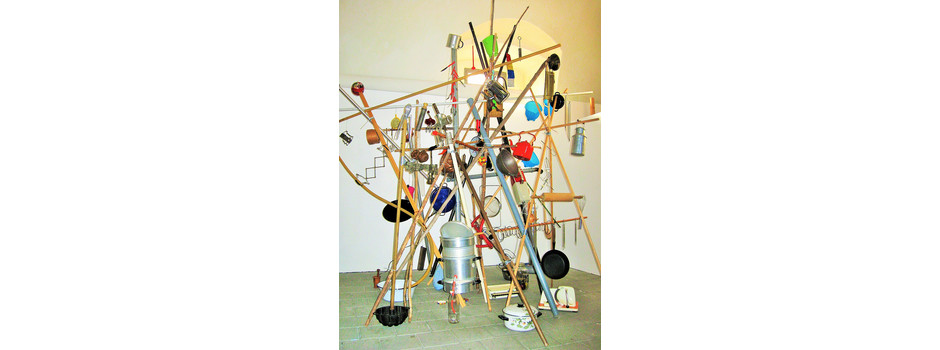
Eating is Identity
Every meal sends a signal of care, attention, and acceptance. Cooking culture and eating habits reflect changes in society, conflicts between inherited traditions and modernisation, frictions between regional and ethnical identities, and processes of rising diversity and pluralisation. Communities of families, relatives or villages react sensitively and emotionally to these changes and develop strategies to deal with them.
Families in a village in Mali produce the traditional, but very laborious, millet polenta as long as the oldest grandmother of the family is alive. Young women in an Andean village serve new industrial sweets at the birthday parties of children or elder women instead of traditional food (Graf 2017; Baecker2017).
Food from our childhood ties us to our families and is mostly affiliated with warm feelings and memories. “Foods from our culture, from our family often become the comfort foods we seek as adults in times of frustration and stress” (Almerico, 2014: 5). In this regard, Deana Maksimovic-Vidanovic, Blogger from Belgrad and Karlsruhe, and protagonist in the exhibition remarks on storytelling of forgotten delicacies:
Deana Maksimovic-Vidanovic is a philologist who loves photography as well as the preparation of cakes and pastries. She was born in Serbia and has been living with her family in Karlsruhe (Germany) since 2001. The idea of starting a blog based on old recipes came from the handwritten cookbook of her grandmother Spomenka Strunjas. Wanting to save this cookbook as a part of her family heritage and to pass it to her daughter, she began to try out the recipes, to take pictures of successfully made desserts, to write texts, and to publish them.
Each of Deana’s texts contains the original version, information about the changes she had to make to adapt the recipes to her environment and the food available today, as well as nice pictures of the food. In addition, she tells some stories of women from her family. Grandma Spomenkas’s recipes are applied by numerous followers of the blog all over the world. “I owe it to those who are no longer with us and those who have yet to take the wooden spoon into their hands”.
Eating is a daily confirmation of cultural identity. Here, Rita Bariche, Frankfurt, initiator of the Syrian “Diaspora Cuisine”, and protagonist in the exhibition gives a lively example: Cooking against homesickness:
Rita Bariche had to leave Syria in 2013. Her ’soul foods’ are the seven spices that her mother had put into her suitcase, a small plastic bag, very well tightened. On lonely evenings, she started to cook with these ingredients to defeat the homesickness, to bring peace to her soul. With the upload of her creations of Syrian meals to her Facebook page, the idea of “Diaspora cuisine – AKA. Matbkh Gherbeh” was born. Syrians, suddenly dispersed all over the world, started to interact, to express their nostalgia, to confirm their identities through images of their nostalgia cooking. Today, more than 8,000 Syrians living in exile share recipes and inform each other of appropriate alternatives and available substitutes to original ingredients. But most importantly, they started talking to each other again after a long fracture due to their differences regarding the situation in Syria.
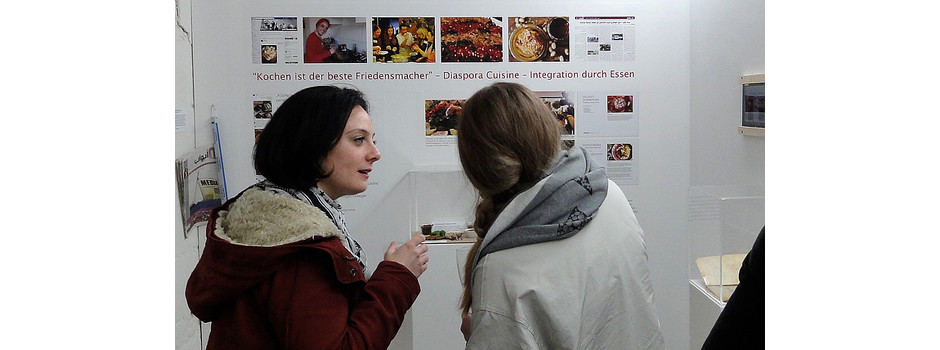
Meals are the ties that bind
“Let’s eat together” – nearly all social interactions all over the world start with an invitation to share a drink or a meal. In all cultures, food functions as a medium to express feelings of belonging, of sharing and acceptance, in everyday life and certainly also in times of celebration or mourning. An ethic of sharing is associated with various types of meals given and offered – mostly by women. Shared meals are expressions of both social and cultural values. Food may have changed in many cultures from necessity to matters of comfort or even luxury, but it still plays a role in distinctions between work and pleasure and between ’them’ and ’us’. Maybe this was easier in times when families lived closer together and neighbourhoods and communities supported each other. Nowadays, the conditions for communal meals have to be created and organized in a new way.
There are many co-cooking and eating projects that target specific groups, children, adolescents in difficult circumstances, the elderly, people with low incomes, people living in deprived neighbourhoods and so on. Preparing meals as a group, paying attention during the process, laying the table, serving the food and eating together opens hearts and minds and stimulates conversations. “The quieting effect of meals, served in nice, friendly surroundings, and eating in small groups is known from Dutch research on dementia” (deVries 2011:8). The elderly get more food and attention, and feelings of belonging and being respected have positive effects on their health, too. It is noteworthy that the power of food also strengthens self-esteem. In some projects, cooking and eating together are also used to open up new horizons in cooking, e.g. to get to know the ideas and rules of ’slow food’, to cook healthier with local and home-grown food, or to combine food leftovers together and thus consciously avoid wasting food.
Cooking and eating are of particular importance for encounters and relationships between people of different cultural backgrounds. The respective favourite dishes of the different countries can be discussed, comparisons, differences and questions help in understanding the culture of the other. In this regard, Ilse Bayer, Rüsselhausen, Baden-Württemberg, and protagonist of the exhibition highlights the importance of creating encounters:
Ilse Bayer is a housekeeper and farmer on a full-time farm. 124 ha of land, 50 cows, and their offspring are managed by the family. In 2015 they switched from conventional to organic farming. “We want to give our next generation a quality life”, is the motto of Ilse Bayer. Because she cannot go on vacation, she brings the world into her home. For nine years now, young people from all over the world come to the farm via a ‘Work and Travel’ program. There were 220 youth who came from far away to help in the house, in the kitchen, in the garden, picking fruit, cooking jam, preserving food, milking, and enjoying meals together. Ilse Bayer brings the Swabian cuisine to her guests, serving to them ‘Spätzle’ noodles, home-made of course, but at the same time she enjoys meals cooked by her visitors from all over the world.
Shared meals are a very efficient basis for understanding: the naming of ingredients, dishes, table cultures etc. let us learn, perhaps the first words, in the language of the other. Common meals quickly draw attention to similarities between cultures and create opportunities for interaction in a friendly atmosphere. Therefore, common cooking and eating in various forms is one of the favourite ways of bringing people together, e.g. refugees and locals. It seems that despite all the changes in the way we deal with food and eating the traditional role of meals has been preserved. You often hear the opinion: “Eating together is the best peacemaker”. In this framework, Zeinab Mohamed Blandia, Sudan, protagonist in our exhibition provides for a practical example: Eating with the “enemy’.
Zeinab Mohamed Blandia from Sudan (born 1960) has been looking after communities in the Nuba Mountains for years, one of the most conflict-ridden regions in the world. She is successful in bringing women from hostile ethnic groups together. She asks the respective hosts of the meetings to cook and serve their traditional dishes. They then share their meals with the wives of the ’enemy group’. They explain their meals, the ingredients used, and their preferred cooking technique. The women compare cooking and meals and can talk peacefully. Gradually, they also manage to talk about similar experiences as women, the struggles of their husbands, their grief, their fear, their mutual animosity. So Zeinab Mohamed Blandia with her pickup truck often transports women from the hostile ethnic groups back and forth between their villages. She also successfully applied her method of exchanging experiences about cooking and eating in a refugee camp, where women of hostile groups lived next to each other.
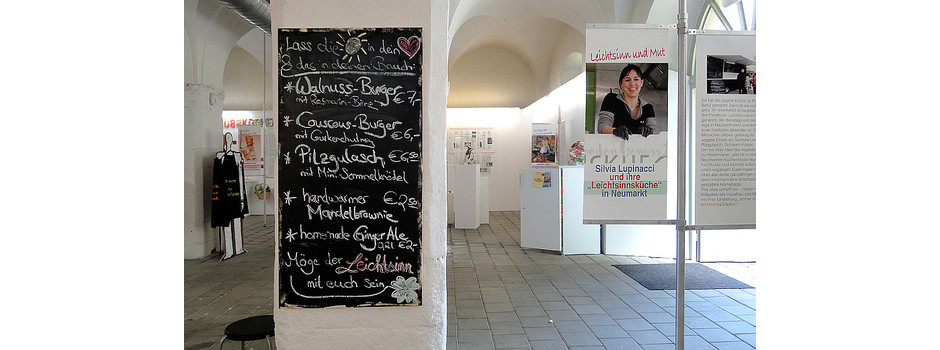
References
Almerico, Gina M 2014. “Food and Identity: Food studies, cultural and personal identity”. In: Journal of International Business and Cultural Studies, vol. 8, June.
Baecker, Antje 2017. “Wie sich Frauen in den Anden ihr Essen mit neuen Speisen versüßen”. In: Cyprian, Gudrun and Gaby Franger (eds.), ausgekocht? Nürnberg, pp.224-229.
Cairns, Kate and Josée Johnston. 2015. Food and Femininity. New York.
De Vries, Ally 2011. “Meals – Old Ways and New Horizons. A Personal Review”. In: Meal Cultures in Europe, Changes and Exchanges, EU-Grundtvig-Workshop, 20.-27. 02.2011, Berlin, https://mealcultures.files.wordpress.com/2011/05/mealcultures_final-web_02.pdf, [last access10.1.2018].
FAO, IFAD, UNICEF, WFP and WHO 2017.The State of Food Security and Nutrition in the World 2017.Building resilience for peace and food security. Rome, FAO.
Franger, Gaby 2017: “Und was haben die Tomaten mit Flüchtlingen zu tun?” In: Cyprian, Gudrun and Gaby Franger (eds.), ausgekocht? Nürnberg, pp. 52-53.
Graf, Katharina 2017. “Hausgemacht! Die anhaltende Bedeutung häuslicher Nahrungszubereitung”. In: Cyprian, Gudrun and Gaby Franger(eds.), ausgekocht? Nürnberg, pp. 128-132.
Herre, Roman 2017.“Wege aus der Hungerkrise”. In: Food First 4/2017.
Sen, Amartya. 1981. Poverty and Famines: an Essay on Entitlement and Deprivation. New York.
Teherani-Krönner, Parto 2011.“Meals are the Ties that Bind”. In: Meal Cultures in Europe, Changes and Exchanges, EU-Grundtvig-Workshop 20.-27. 02.2011, Berlin, https://mealcultures.files.wordpress.com/2011/05/mealcultures_final-web_02.pdf, [last access 10.1.2018].
Teherani-Krönner, Parto and Brigitte Hamburger (eds.) 2014. Mahlzeitenpolitik. Zur Kulturökologie von Ernährung und Gender. München.
Welthungerhilfe. 2014.“Factsheet. Frauen und Entwicklung”, https://www.welthungerhilfe.de/fileadmin/user_upload/Themen/Frauen_und_Entwicklung/Factsheet_Frauen_2014.pdf [last access 10.1.2018].
This article is published in:
Claudia Lohrenscheit/ Andrea Schmelz (Eds.)Together for Justice and Peace – International Social Work Education, Gender and the Global Goals for Sustainable Development , Oldenburg: Paolo Freire Verlag 2018 ( in print)
[1] ‘Ausgekocht’ was exhibited in 2016 and 2107 in Museum Frauenkultur – Regional International in Fürth, Bayern. From October 2018 until the end of 2019 it will be in Frauenmuseum/ Museo delle donne in Meran, Italy.
[2] This quote as well as the following from “protagonist women” are translations from their testimonies in the exhibition.